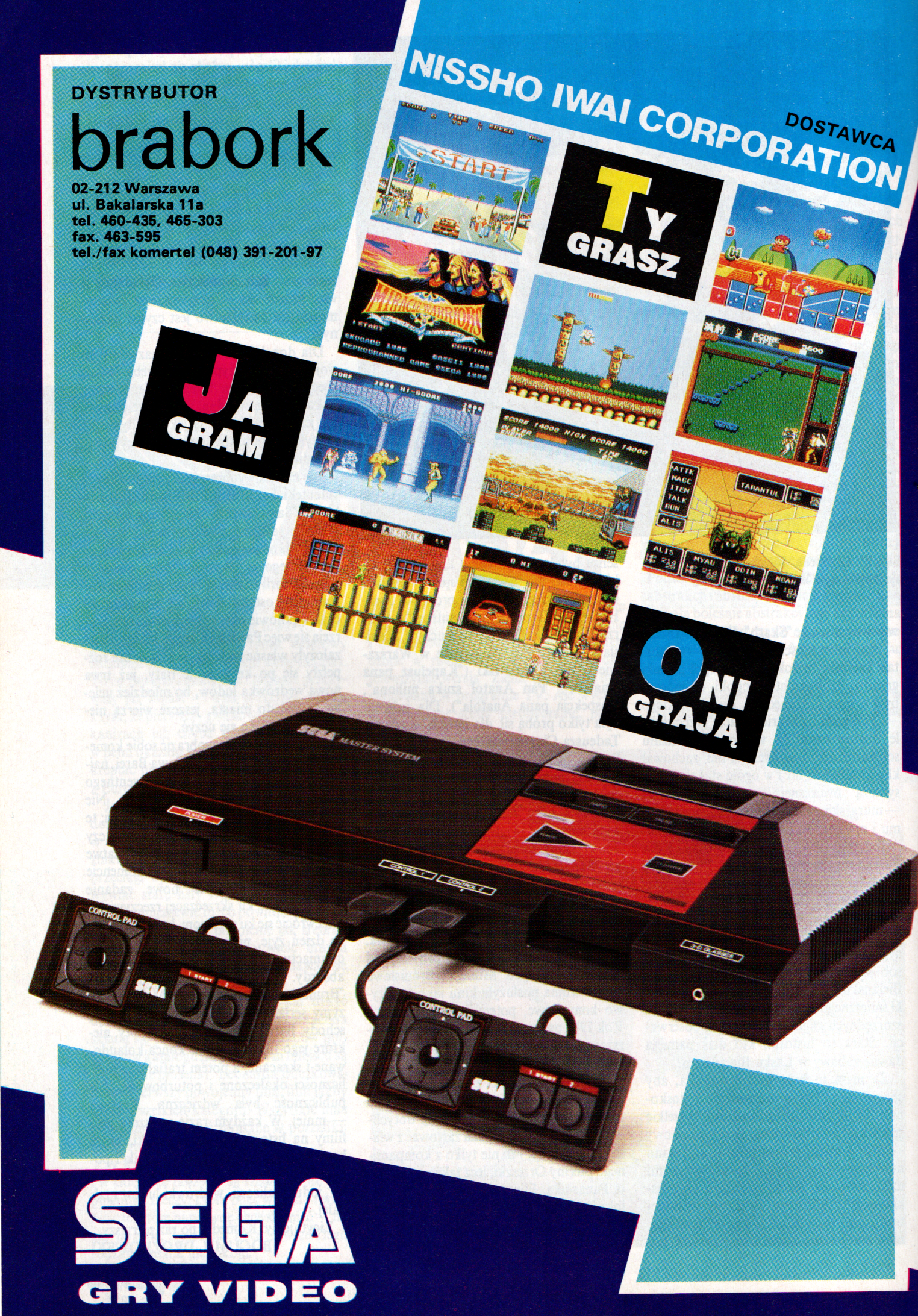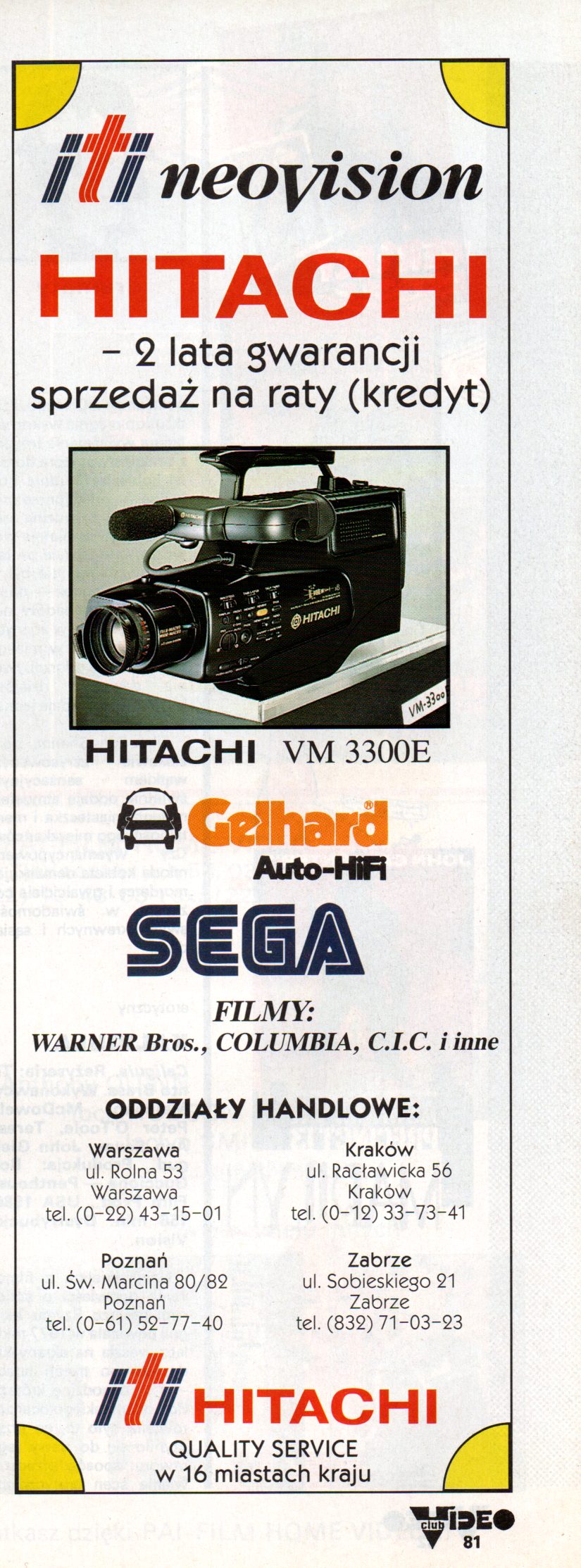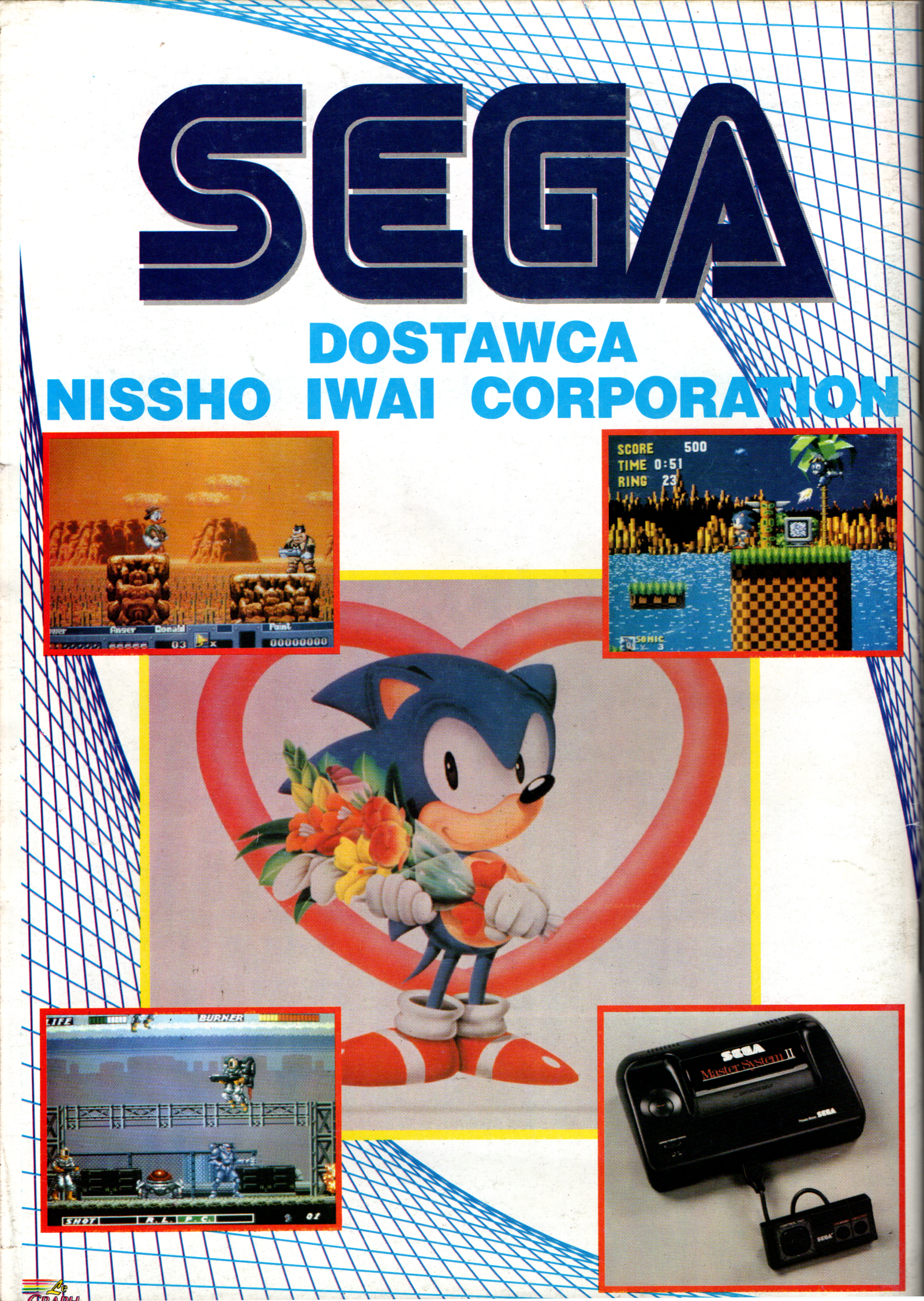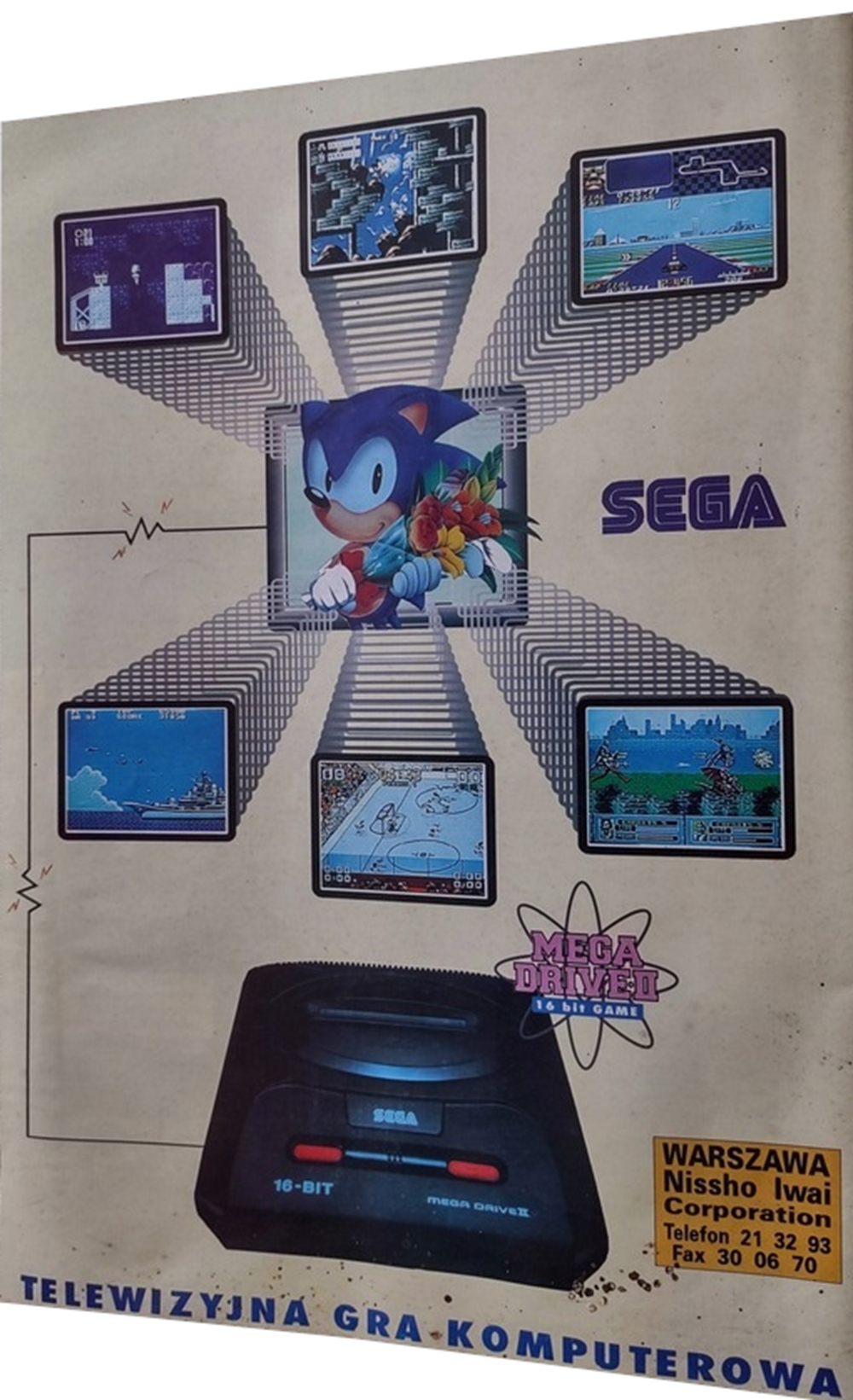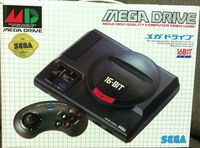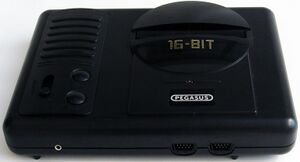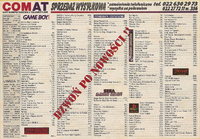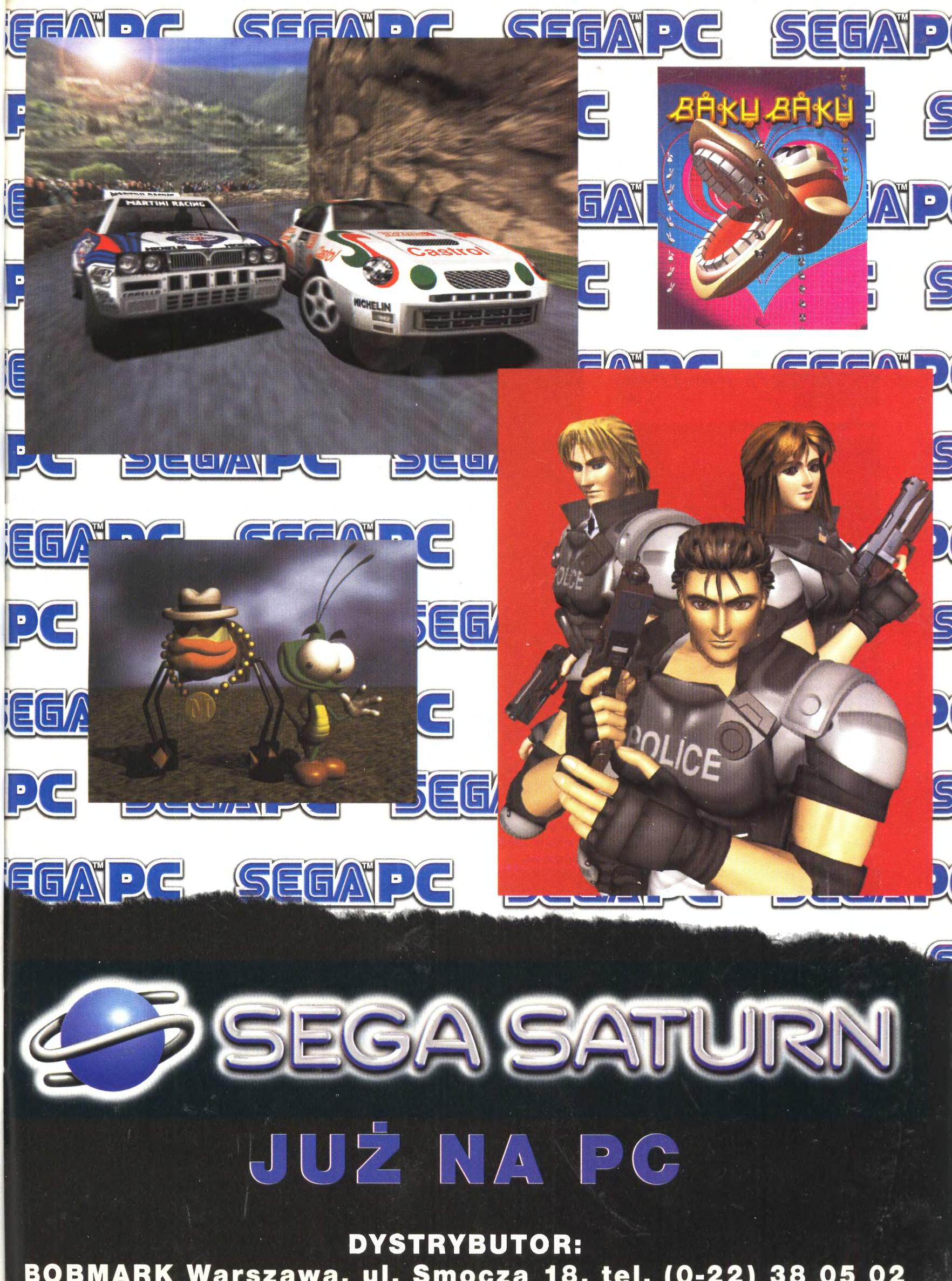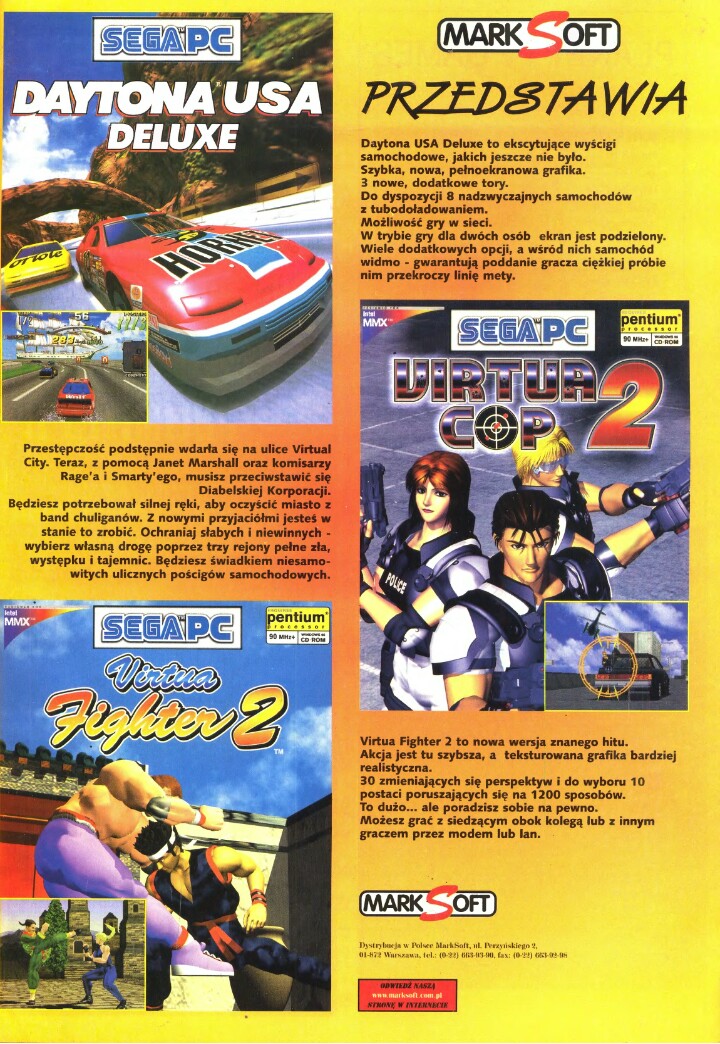History of Sega in Poland
From Sega Retro

|
| History of Sega in Poland |
|---|
| Official Sega distributor(s): Nissho Iwai (1992-1995), Bobmark International (1996-1997), Lanser (1997-2002), CD Projekt (2003-2014), Cenega (2014-present) |
The consoles started their existence in Poland with the Tele-Set GTV 881 produced since 1977 by Unimor. The fall of communist Poland in the September of 1989 led to the peaceful transition to the Third Polish Republic in the years that followed. No longer under strict political regimes and the wider sphere of influence from the Soviet Union, Poland was able to open its markets in the early 1990s, enabling the country to import luxary items (such as video game consoles) from elsewhere.
Contents
Nissho Iwai Corporation
First try (1992-1994)
Like many of its contemporaries, Sega didn't immediately create distribution channels across the former Eastern bloc. In 1991, in other parts of the world, the Blockout game by the Polish California Dreams and Logical Design Works studios was released on Mega Drive. It was the only Polish game for this system.[1]
In early 1992, Nissho Iwai Europe Plc became Sega's agent in Poland and began to create distribution network[2]. Due to the small number of video games retailers at the time, Nissho Iwai decided to sign deal with audio and video resellers (Poland was during the times of massive VHS popularity) and in that way, one of the two biggest companies - Brabork[3] and ITI Neovision[4] became authorized distributors. Nissho began to deliver immediately Sega Mega Drive[5] (1 game and 2 control pads) and Sega Master System I[6], II[7] with 50 titles for 16-bit system and 100 titles for 8-bit system available from the start[8]. Radioelektronik magazine reported that few of the games had instructions in Polish[4]. In 1993, Nissho Iwai delivered to Poland Game Gear and Mega Drive II[9]. They had competition in form of Pegasus (famiclone distributed from 1991 by Bobmark International), CDTV (distributed from October 1991 by JTT Computers[10]), Atari Lynx (distributed from 1991 by JTT Computers[11]), Rambo TV Game (Atari 2600 clones distributed from <1990) and Supervision (distributed by Multi-Styk)[12].
Unfortunately, the project was a failure. The main reason for this was poor promotion based on advertising products mainly in Video and Audio magazines, which meant the lack of any reviews or commercials in Polish computer games magazines. Also, the general availability of products in the country was average. On the positive side, distributors had their branch stores in many places (for example, ITI Neovision had branches in 16 cities, both small and large), but on the other side, apart from these two companies, the consoles were not resold to smaller retail chains. It is worth to mention that between 1993 and 1994 there was a massive decline on the VHS market. In the times of Nissho Iwai, most of the people got Sega consoles from abroad. Instead of Sega video games, much better advertised Pegasus console, became popular around the region.
Top Secret editors made in 1994 a poll which revealed that readers have the following consoles: CDTV-10%, Pegasus/Nintendo/Game Boy/Supervision-8%, Mega Drive/Sega-1%, Others-3%.[13]
- Video Club (PL) #19: "04/1992" (1992-xx-xx)
- Video Club (PL) #30: "03/1993" (1993-xx-xx)
- Video Club (PL) #31: "04/1993" (1993-xx-xx)
- Video Club (PL) #32: "05/1993" (1993-xx-xx)
also published in:
- Video Club (PL) #37: "10/1993" (1993-xx-xx)
- Video Club (PL) #38: "11/1993" (1993-xx-xx)
- Video Club (PL) #39: "12/1993" (1993-xx-xx)
Second try (1994-1996)
Pegasus
Starting from 1991, Polish based company Bobmark International, began distributing Pegasus consoles - a clone of the Nintendo Famicom. The Pegasus line would become the dominant console across Poland, however May 1994 saw a change in the law preventing Bobmark from selling another unlicensed system[14]. Not wanting to give up a still profitable business, they released new model called "IQ-502" with unique design unlike any other on the market and got rights to distribute unlicensed Famicom games that weren't associated with licensed games, hacks or bootlegs of existing games from Codemasters and Sachen. This changes also caused interest of Sega and Nintendo who started talks with national distributors about selling their consoles. Bobmark known that year by year, selling unlicensed stuff would become more and more difficult wanted to slowly change it's profession from selling unlicensed to licensed stuff, so decided to participate in the talks.
Deal with Sega
In July 1994 Bobmark created a new company, trading as AGES ("Sega" reversed) specifically to distribute Sega systems. Nissho Iwai wanted to try again and chose a few Polish companies as authorized distributors to market Sega products in the country, that this time were not only audio and video distributors but also video game resellers. So far, name two of sub-distributors have been confirmed - AGES and Bemex, but it could be more, beacuse certain enterprises like Discomp[15], Comat[16], CMR Digital[17] and Hegatar (same that sold clones few months before, which now began to trade in more legal ways)[18] where also involved in active promotion of Sega products, but these are unconfirmed. They began to distribute Sega Mega Drive[19] alongside with Sega Master System II[20] and Sega Game Gear[21]. Original Sega consoles, like these produced by Nintendo, Atari or Commodore could be bought mainly in big cities such as Warsaw, Wrocław, Katowice, Kraków, Poznań, Łodż etc. however, distributors ensure that from month to month the number of stores selling consoles and video game rental shops in other cities was constantly increasing[22].
Mega Drive clones
Like in many other countries of Central Europe, video game piracy of Sega consoles was presence here as well. One of the first clones was Super Drive, distributed from October 1993 by Hegatar Computing. The price of this console ranged from 3500000zł — 4000000zł in late 1993 - early 1994 (console, 2 six button pads and Sonic the Hedgehog), while the games could be bought for 500000zł — 1000000zł.[23]
In the following months and years, another clones were brought to Poland such as Macro Drive (sold by ElektroTEL), High Quality (sold by E-Moll, Centrum Gier TV and Biwit), Hunt 16 bit (sold by E-Moll), Mega Drive 2 (Atlanta) (by F.A.V. Studio), MEGA+Plus2 Neon (by Biwit), Pro 16 Bit (by Biwit), KW-500 and others called simply 'Mega Drive' or 'Mega Drive 2'. Many owner were unaware of the bootleg nature of this clones and in later years said that they had Japanese Sega (due to box cover), wrongly thinking that this consoles were original.
From mid-1994 unitl late 1990s, price of clones depending on the model, games included in the set and reseller was usually around 250zł — 300zł (console, 2 six button pads) and 300zł — 350zł (console, 2 six button pads, 1 bootleg game) while bootleg titles cost mostly around 40zł — 120zł. In comparison, the original models cost 350zł and more (console, 1 three button pad), and the original games cost 80zł — 200zł. Systems were sold by smaller distributors and electronic shops mainly in mid-size cities (as opposed to original systems available mostly in larger towns), or big conurbation as competition for official retailers. Some were even accessible on flea markets/market stalls thanks to sellers from the East Europe (Russia, the Caucasus States etc.) who brought clones with games from their countries. Occasionally, people could come across famiclone reminiscent of the Mega Drive in a green box from Asian distribution which cost more than 140zł. Many smaller stores began to keep up with selling Famicom and Sega clones, and first option was mostly for lower class and the second one for middle class (a group that was also in attention of legal sellers). In addition to clones, there was a significant market of importers among whom it was popular to import used cartridges from Western Europe (usually Germany)[24]. When PlayStation (and piracy of this system) began to be more popular among middle class after mid-1996, small stores began to switch to this system [25][26].
Sega Marketing and Power Pegasus
At the begining of 1995 in addition to the Pegasus and Sega clones, more and more powerful consoles such as Super Nintendo, Nintendo Entertainment System and Game Boy (distributed from October 1994 by Entertainment Systems Poland and retail chain of 4 authorized distributors[27]), 3DO (distributed from March 1995 by Discomp[28]), Amiga CD32 (distributed from August 1993 by Commodore Poland[29]which distribution was taken over from October 1995 by APS and BI&K[30]) and Atari Jaguar (distributed from December 1994 by ATAR System, which distribution was taken over in May 1995 by Mirage Media[31]) were advertised.
In March 1995 Bobmark announced Pegasus 16-bit on Play Box 95[32]. They also tried to promote consoles on biggest electronic fairs like Gambleriada I, mentioned earlier Play Box 95 and more adverts about Sega began to pop up in comics and magazines. In the meantime, Poland saw release of Mega CD II in early 1995[33](with Road Avenger game) and Mega Drive 32X in mid-1995[34], but these systems, like in rest countries of that region, were offered by the most specialized retailers[35]. The country also got releases of English versions Sega Pro and Saturn Plus by Hegatar Computing that cost around 20zł - 30zł.[36][37] The release of Sega Saturn was moved due to news about console problems in the United States.[38] Instead (and possibly with the blessing of Sega), Bobmark began selling the unlicensed Taiwanese-built KW-501 Mega Drive clone as the Power Pegasus. Released in the Autumn 1995 in preparation for Christmas and hoping to trade off a more successful brand, it too failed to catch on. The system was poorly promoted which resulted in his disappear among stronger competitors, both from original and clone side[39][40]. Pricing in Bobmark stores looked as follows - Mega Drive with 1 three button control pad cost 350zł, Power Pegasus with 1 six button control pad and 1 original game cost 329zł. It was also the last year in which Bobmark made a profit. If it comes to Console Wars of 16-bit video games, rivalry between Mega Drive and Super Nintendo in Poland still continued in 1996-1998 (read Mega Drive situation on bottom).
Polish comapny MATT, released in late 1995, third-party control pad, compatible with Mega Drive and Master System called Boomerang[41].
The editors of Top Secret made a poll which revealed that in 1995, 28.6% of readers own consoles. This is the percentage of people who have the following consoles: Pegasus-38%, 16-bit and 32-bit devices[42] (no dominant console) -30.7%, Game Boy-16%.[43]
also published in:
- Wojownicze Żółwie Ninja (PL) #2/95 (1995-xx-xx)[47]
- Bajtek (PL) #1995-04 (1995-xx-xx)[48]
- Top Secret (PL) #37: "Kwiecień 1995" (1995-xx-xx)[49]
- The Amazing Spider-Man (PL) #58: "4/95" (1995-xx-xx)[50]
- Mega Marvel (PL) #7: "2/95" (1995-xx-xx)[51]
- Batman (PL) #53: "4/95" (1995-xx-xx)[52]
- Bajtek (PL) #1995-05 (1995-xx-xx)[53]
- Top Secret (PL) #38: "Maj 1995" (1995-xx-xx)[54]
- The Amazing Spider-Man (PL) #59: "5/95" (1995-xx-xx)[55]
- G.I Joe (PL) #27: "3/1995" (1995-xx-xx)[56]
- Batman (PL) #54: "5/95" (1995-xx-xx)[57]
- X-men (PL) #27: "5/95" (1995-xx-xx)[58]
- Transformers (PL) #24: "3/95" (1995-xx-xx)[59]
- Bajtek (PL) #1995-06 (1995-xx-xx)[60]
- Top Secret (PL) #39: "Czerwiec 1995" (1995-xx-xx)[61]
- Bajtek (PL) #1995-07 (1995-xx-xx)[62]
- Top Secret (PL) #40: "Lipiec 1995" (1995-xx-xx)[63]
- Bajtek (PL) #1995-08 (1995-xx-xx)[64]
- Top Secret (PL) #41: "Sierpień 1995" (1995-xx-xx)[65]
- Bajtek (PL) #1995-09 (1995-xx-xx)[66]
also published in:
- Casper (PL) #4/95 (1995-xx-xx)[67]
- X-men (PL) #34: "12/95" (1995-xx-xx)[68]
- The Amazing Spider-Man (PL) #66: "12/95" (1995-xx-xx)[69]
- G.I Joe (PL) #30: "6/1995" (1995-xx-xx)[70]
- Batman (PL) #61: "12/95" (1995-xx-xx)[71]
- The Adventures of Superman (PL) #61: "12/95" (1995-xx-xx)[72]
- Tom & Jerry (PL) #12/95 (1995-xx-xx)[73]
- Gry Komputerowe (PL) #24: "3/1996" (1996-xx-xx)[74]
Bobmark
Saturn marketing
In January 1996, Bobmark got full exclusive distributor license from Sega Europe, which in the meantime replaced Nissho Iwai in Eastern Europe. On electronic fair called Play Box 96 that took place on March 1, 1996 they announced Polish release of Sega Saturn[75]. Although the console could be bought from Bobmark's headquarters since then, full retail sales to other shops was start on May 10, 1996 at Gambleriada Wiosna 1996 fair where Bobmark also released Sega Rally (Saturn), Panzer Dragoon Zwei (Saturn) and Toy Story (Mega Drive). The products were sold with warranty service from Eltors Electronic. Poland was the second priority market among the former Eastern Bloc countries due to the second largest population in the region and the improving economy[76]. The whole 1996 was marked by an aggressive advertising campaign in video game magazines and comic books against Sony PlayStation (which was released on January 1, 1996 by Lanser and in June 1996 taken over by Sony Poland[77]).
Initially Sega cost around 1200zł and PlayStation around 1600zł, but Sony Poland lowered prices to 1399zł, before summer. As part of the marketing campaign, it was announced from June 1996 that the Saturn at the Bobmark's headquarters and in Makro Cash & Carry stores will cost 999zł while in other stores, the console with the game Daytona USA will be available for 1198zł.[78] After summer, Sony made the promotion for 999zł and lowered the price of games, something that Bobmark didn't do and difference was about 20zł[79]. System was heavily promoted during Gambleriada Jesień 1996 where the Bobmark section with Sega consoles was considered one of the best due to car from Sega Rally standing in front of stand. In this event Sega had special conference where promoted new games like Nights (which was heavily advertised from August), Virtua Cop 2, Fighting Vipers, Worldwide Soccer 97 and Virtua Fighter 3 with it's own dedicated tournament called Turniej Virtua Fighter 2. In the meantime Bobmark sponsored a new TV program called Escape which give them chance to broadcast ads for Sega consoles on TV.
also published in:
- Amiga Computer Studio (PL) #6/96: "Wrzesień 1996" (1996-xx-xx)[84]
- Secret Service (PL) #38: "Wrzesień 1996" (1996-09-01)[85]
- Gry Komputerowe (PL) #28: "9-10/1996" (1996-xx-xx)[86]
- Amiga Computer Studio (PL) #7/96: "Październik 1996" (1996-xx-xx)[87]
- PC Gamer Po Polsku (PL) #4: "Październik 1996" (1996-xx-xx)[88]
- Secret Service (PL) #39: "Październik 1996" (1996-10-01)[89]
- Secret Service (PL) #40: "Listopad 1996" (1996-11-01)[90]
- Gry Komputerowe (PL) #29: "11/1996" (1996-xx-xx)[91]
- Amiga Computer Studio (PL) #8/96: "Listopad-Grudzień 1996" (1996-xx-xx)[92]
- Secret Service (PL) #41: "Grudzień 1996" (1996-12-01)[93]
- Gry Komputerowe (PL) #30: "12/1996" (1996-xx-xx)[94]
- Amiga Computer Studio (PL) #1/97: "Styczeń-Luty 1997" (1997-xx-xx)[95]
- Amiga Computer Studio (PL) #2/97: "Marzec 1997" (1997-xx-xx)[96]
Mega Drive situation
One of the Bobmark's founder said that due to existing significant group of MD owners in Poland which was result of imports, clones and activities of the former distributor, they are mainly interested in importing and selling games for the 16-bit system, and they want to convince users with quality of the original games, because bootlegs that are still available on the market, are inferior despite the low price[103]. One of the marketing moves from them was adding Master System Converter for free to all remaining 8-bit games, which really pay off for MD users[104], due to the fact that the prices were low and many cheap MSII cost around 30zł - 50zł. The price of the Mega Drive's II "basic set" from March 1996 was 399zł, sold with 1 control pad and 1 free multigame Mega Games I[105] and price of "Extra 3" set with 1 controller and 3 old games was 459 zł. Game Gear was priced 370zł for Sonic 1 and AC adaptor but with 1 free multigame Sega Game Pack 4 in 1 was priced 410zł. They also traded hardware and software remaining from AGES distribution until stocks were exhausted, that is Mega Drive I with 2 three button pads and Sonic 1, Master System II with 2 pads and Sonic 1, Mega CD II with Road Avenger and Mega Drive 32X, with games all at a more affordable price than before. Occasionally, people could come across remains of Power Pegasus for around 300 zł, which was last seen in late 1996 as a prize in the Kalambury show along with Sega Saturn[106]. The MD was doing better in Poland and ever since Sega said it would support the sale of Mega Drive in Eastern Europe, more local retailers have started trading the console[107]. Sega's support was mostly because of market analyzes which predicted that until at least 1998, 8-bit and 16-bit systems would be dominant in Central and Eastern Europe and not threatened by 32-bit consoles[108]. It can be said that since this year, 16-bit consoles have finally settled in Poland[109]. This could be seen on the basis of magazines such as Secret Service, where in 1996, 20% of readers own consoles (PSX - 5%, Pegasus - 4%, CD32 - 3%, Jaguar - 2%, Game Boy - 2%, Rest[110] - 4%)[111] and in 1997 already 27% of readers own consoles (PSX - 5.7%, Game Boy - 5.6%, Mega Drive - 2.4%, Saturn - 2%, CD32 - less than 2%, SNES - less than 2%, Nintendo 64 - less than 2%, Others - less than 6%).[112] The representative of Bobmark assured at Gambleriada Jesień 1996 that the company is aware of the existence of a wide group of Mega Drive owners in Poland and will continue to support the console so that the owners don't have to throw it away[113]. In middle of this year, Klub Sega was established by Tomel TV Games, a service in which members could purchase games for every Sega console with 20% discount in headquarter or exchanged by mail with the store and other club members.
The exact sales results of Mega Drive and Super Nintendo have never been given, but based on observations, many estimates that Sega had better resultes. The Sega's 16-bit console gained partial popularity in the country, mainly in cities, where the availability of system was much bigger. This also dependent on the fact that products such as Mega Drive, Game Boy, Amiga CD32 were more often chosen in Poland mainly by the middle class or people who saved money for a long time and these two were not as big as the lower class which dominated society at that time, choosing Famicom clones to buy.
One of the few elements of support by Sega was the purchase in January 1996 by TCI's technology group the rights to distribute Sega Channel in Poland.[114] Although it is not known whether the service started in this country it is known from the annual reports that TCI owned shares in several Polish companies.[115]
Leaving the market
In 1997, Saturn's advertising began to slowly disappear. The last big promotion was Wygraj Samochód z Sega Saturn (October 1996-April 1997) and last electronic fairs that Sega took part was Play Box 97 (February 1997) and Infosystem'97 (April 1997). This year stood under a rapid decline in the price of the console to adapt to the Playstation and Nintendo 64 (distributed from March 1997 by Entertainment Systems Poland and retail chain of 3 authorized distributors), with the price difference between Saturn and PSX games, despite the reductions, was always around 20zł. Despite the fact that Sega's 32-bit console gained significant popularity in Poland[116] and number of users was at the same level as PlayStation for the most time, Sony's console began took over the position of dominate console from mid-1997, due to the lower prices of games, growth of piracy, lack of new console ads and global Sega politics. In September, Bobmark, knowing that in the 1996-1997 suffers big losses and Saturn lost battle with competition, decided to end the contract with Sega. Founders of Bobmark continue to sell Pegasus until 1999, when they decided to focus on established in 1993 drink producer Hoop company which began to make a lot of more money than consoles distributor.
Lanser
Return of Saturn
In October 1997, Lanser was chosen as the official exclusive distributor of Sega in Poland and already on Gambleriada V (October 24-26, 1997) it started the promotion of the Sega Saturn[117] and reduced the price of the console to 699zł, which was 50zł less than the PlayStation. At this price, in addition to the standard set, customer got a Voyager pad, a discount of 10zł on each title purchased with shipment from Lanser, and for sending the registration card, customer got 3 issues of the Neo magazine for free. Additionally, Lanser has released some interesting Saturn sets with additional games to choose from, at very attractive prices.[118]Furthermore, Lanser offered Voyager pad for free, for buying two Saturn games. Many magazines have Dlaczego Saturn ?! ad where, based on the story of a 16-year-old boy, it was explained why Saturn is a better choice than other consoles.
From 1998, certain importers have started selling Sega Nomad.
also published in:
- Świat Gier Komputerowych (PL) #59: "11/1997" (1997-xx-xx)[119]
- Gry Komputerowe (PL) #41: "12/1997" (1997-xx-xx)[120]
- Świat Gier Komputerowych (PL) #60: "12/1997" (1997-xx-xx)[121]
- Neo (PL) #2: "Grudzień 1997" (1997-xx-xx)[122]
- Świat Gier Komputerowych (PL) #61: "1/1998" (1997-xx-xx)[123]
- Secret Service (PL) #53: "Styczeń 1998" (1998-xx-xx)[124]
Dreamcast
When Sega Dreamcast was released in Europe, none of the distributors was selected due to Sega's intention to focus on the most key markets (UK, Spain, France, Germany), which wasn't new thing, because Sega had logistic problems and many other countries of the region had same issue as Poland. Lanser which was technically still distributor was rejected, due to unknown reasons and focused on selling Neo Geo Pocket Color instead. Only retailers who started importing consoles with games and accessories from Germany remained. Dreamcast cost 1,500zł and games 250zł so retailers planned to sell at least 1,000 consoles in 1999.[125][126]
On October 18, 2000, Lanser signed a contract with Sega for the distribution of Sega Dreamcast. The premiere was announced on December 1, 2000[127] at a starting price of 999zł[128] with release of 45 games on this day[129]. Back of the boxes were translated into Polish using self-made stickers, but initially, Polish instructions were also announced. As part of a continental strategy against the PS2, it was planned to add a DVD discount voucher but Sega withdrew from that idea in Europe. In large supermarkets, Lanser set up stands with Dreamcast and everyone could test the it. For sending registration card, distributor planned to send special info about news and user could gather points from buing DC stuff and later exchange it to special gadgets[130][131]. In November, number of available software from the start was increased to 49 titles and 20 new games were announced by the end of the year.[132]Polish version of Dreamcast Internet was announced for the third-fourth quarter of 2001. The late premiere was explained by the price of the console, which in 1999 was not favorable enough for Polish conditions[133].All these findings were further confirmed at the press conference held at the System 2000 fair[134].
During his lifetime, Dreamcast was called DeCek or Makaron (eng. Pasta) because of its logo.[135]Sega had competition in form of PlayStation 2, distributed by Sony Poland and retail chain of 4 authorized distributors (one of them was Lanser) from November 28, 2000 (two days before Dreamcast), but console was extremely expensive costing 2699zł. Until March 2001, there were 15,000 Dreamcast console owners versus 1,000 PS2 owners in Poland.[136]Around 10,000 units of DC were sold by importers until December 2000[137], and rest 5,000 units were sold by Lanser in December 2000 - March 2001 period. After reducing prices in March 2001 to 699zł, Lanser managed to sell over 10,000 consoles until September 2001[138]. This month also saw another cut to 499zł, which enabled to remain with console sales at the same level as in previous months until stocks ran out in mid-2002. The game piracy for Dreamcast existed in Poland and standard bootleg disc cost 20zł - 50zł and Russian bootlegs called Ruskie tłoki less than 100zł.[139][140]
From February 2001, there was a plan to release a Dreamcast magazine called My Dream, but further details are unknown[141].
The only known Polish game for this system was Kao the Kangaroo[142].
also published in:
- Click! (PL) #24-2000: "24/2000" (2000-11-23)[143]
- Neo Plus (PL) #26: "Listopad 2000" (2000-xx-xx)[144]
- CD-Action (PL) #55: "12/2000" (2000-xx-xx)[145]
- Click! (PL) #25-26-2000: "25-26/2000" (2000-12-07)[146]
- Neo Plus (PL) #27: "Grudzień 2000" (2000-xx-xx)[147]
- Komputer Świat Gry (PL) #9/2000: "Grudzień 2000" (2000-xx-xx)[148]
- CD-Action (PL) #56: "1/2001" (2001-xx-xx)[149]
- Neo Plus (PL) #28: "Styczeń 2001" (2001-xx-xx)[150]
- CD-Action (PL) #57: "2/2001" (2001-xx-xx)[151]
- CD-Action (PL) #58: "3/2001" (2001-xx-xx)[152]
- CD-Action (PL) #59: "4/2001" (2001-xx-xx)[153]
- CD-Action (PL) #60: "5/2001" (2001-xx-xx)[154]
- CD-Action (PL) #61: "6/2001" (2001-xx-xx)[155]
Sega PC games (1996-2002)
From November 1996 to September 1997, Bobmark was responsible for the distribution of Sega PC games. The company did this in co-operation with Mirage Media, which provided its distribution network[156]. After end of partnership, CD Projekt got license for a short time and released Manx TT Super Bike before Christmas 1997[157]. From early 1998, the sale has been taken by Marksoft[158] which promoted games in magazines and events like Gambleriada VI. Sega Rally 2 was distributed again by Mirage Media[159]. The Sega PC games released by Empire as Xplosiv were distributed by Techland from 2001. When Sega began to port Dreamcast games for PC, IM Group released it in 2002.
also published in:
- Secret Service (PL) #55: "Marzec 1998" (1998-xx-xx)
- PC Gamer Po Polsku (PC) #19: "3/98" (1998-xx-xx)
Sega amusement machines
In the 80s places with arcade machines were quite rare in Poland. Instead, the barracks with arcade machines that traveled around various places become popular. Initially, they were part of the circuses, which is why some called them the Drzymała's wagon. In early 90s, arcade saloons began to pop up and it was even possible to see some very old machines like Periscope or Night Rider. Over the 90s, arcade machines became more widespread and one of the most popular games at the time was Outrun. Sega arcades were distributed from at least mid-90s by Deith Leisure Warszawa. Bobmark and Lanser presented some of the Sega machines at gaming events. Deith Leisure funded arcade machine to popular Polish shows like Czar Par[161]. With the end of the era of arcade machines in the rest of the world, this fashion also reached Poland.[162][163]
Nowadays, Sega arcades are distributed by Magic Play and Eurogames.[164][165]They can be found in some shopping centers.
CD Projekt and Cenega
In 2003, CDP became the exclusive distributor of Sega products.[169] The cooperation lasted until 2014 in which the functions of the distributor were taken over by Cenega. This was due to problems in the CDP company.[170]Cenega is still the official representative of Sega in Poland and throughout the Visegrad Group.
References
- ↑ http://pixelpost.pl/karen-logical-desing-works-i-dzial-oprogramowania-eksportowego/
- ↑ Video Club #20 Sega Już w Polsce page 23
- ↑ Video Club #18 Sega Video Gra apge 23
- ↑ 4.0 4.1 File:Radioelektronik_PL_01.pdf, page 37
- ↑ Video Club #20 Sega Już w Polsce page 23
- ↑ Video Club #18 Sega Video Gra page 22
- ↑ Video Club 06/1992 "Sega co dalej ?" page 23
- ↑ Video Club #20 Sega Już w Polsce page 23
- ↑ Video Club #36 "Telewizyjna Gra Komputerowa" page 68
- ↑ https://archive.org/details/TopSecret08/page/n35/mode/2up
- ↑ https://archive.org/details/TopSecret07/page/n33/mode/1up
- ↑ https://archive.org/details/TopSecret19/page/n7/mode/2up
- ↑ Top Secret 8/1994 Bezkarnosc Gwarantowana III
- ↑ https://isap.sejm.gov.pl/isap.nsf/DocDetails.xsp?id=wdu19940240083
- ↑ https://archive.org/details/gry-komputerowe-1995-06/page/32/mode/2up?view=theater
- ↑ https://archive.org/details/gry-komputerowe-1995-11/page/36/mode/2up?view=theater
- ↑ https://archive.org/details/gry-komputerowe-1995-10/page/n11/mode/2up?view=theater
- ↑ https://archive.org/details/gambler_magazine-1994-12/page/n57/mode/2up
- ↑ Sega Mega Drive - Videoman 1995
- ↑ Gra telewizyjna Sega Master System II - Kaczor Donald 17-18/1994
- ↑ Sega Game Gear - Videoman 1995
- ↑ File:Gambler_PL_16_1995-03.pdf, page 32
- ↑ Komputery kontra Konsole - Gry Komputerowe 4/1994 page 12
- ↑ PSX Extreme #323 page 35
- ↑ https://archive.org/details/PSX_Extreme_106/page/n63/mode/2up
- ↑ https://www.sbc.org.pl/dlibra/publication/73772/edition/69702/content
- ↑ https://archive.org/details/bajtek199411/page/n8/mode/2up
- ↑ https://archive.org/details/gry-komputerowe-1995-04/page/n9/mode/2up
- ↑ https://www.primostudio.pl/nfsk/komputery/amigacd32.html
- ↑ https://archive.org/details/SwiatGierKomputerowych111995/page/n1/mode/2up?view=theater
- ↑ https://archive.org/details/gry-komputerowe-1995-04/page/n47/mode/2up
- ↑ File:TopSecret PL 38.pdf, page 58
- ↑ https://archive.org/details/gry-komputerowe-1995-03/page/n45/mode/2up?view=theater
- ↑ https://archive.org/details/gry-komputerowe-1995-06/page/30/mode/2up?view=theater
- ↑ https://archive.org/details/TopSecret41/page/n57/mode/2up?view=theater
- ↑ Gry Komputerowe #12 "Hegatar Computing"
- ↑ Gry Komputerowe #25 "Hegatar Computing"
- ↑ https://archive.org/details/gry-komputerowe-1995-12/page/46/mode/2up?view=theater
- ↑ https://www.ppe.pl/news/42248/polski-bialy-kruk-niepublikowane-wczesniej-zdjecia-16-bitowego-pegasusa.html
- ↑ File:Bajtek_PL_1996-01.pdf, page 49
- ↑ https://www.dobreprogramy.pl/@macminik/joysticki-matt-produkt-z-tradycja,blog,109171
- ↑ CD32, Jaguar, Lynx, SNES, NES, Mega Drive, 3DO, Sony PlayStation, Sega Saturn
- ↑ Top Secret 2/1996 Bezkarnosc Gwarantowana IV
- ↑ Kaczor Donald, "1/1995" (PL; 1995-01-05)
- ↑ Kaczor Donald, "2/1995" (PL; 1995-01-19), page 27
- ↑ Kaczor Donald, "3/1995" (PL; 1995-02-02), page 28
- ↑ Wojownicze Żółwie Ninja, "2/95" (PL; 1995-xx-xx)
- ↑ File:Pegasus Golden Five Bajtek 1995.png
- ↑ Top Secret, "Kwiecień 1995" (PL; 1995-xx-xx), page 38
- ↑ The Amazing Spider-Man, "4/95" (PL; 1995-xx-xx)
- ↑ Mega Marvel, "2/95" (PL; 1995-xx-xx)
- ↑ Batman, "4/95" (PL; 1995-xx-xx)
- ↑ Bajtek, "1995-05" (PL; 1995-xx-xx), page 54
- ↑ Top Secret, "Maj 1995" (PL; 1995-xx-xx), page 38
- ↑ The Amazing Spider-Man, "5/95" (PL; 1995-xx-xx)
- ↑ G.I Joe, "3/1995" (PL; 1995-xx-xx)
- ↑ Batman, "5/95" (PL; 1995-xx-xx)
- ↑ X-men, "5/95" (PL; 1995-xx-xx)
- ↑ Transformers, "3/95" (PL; 1995-xx-xx)
- ↑ Bajtek, "1995-06" (PL; 1995-xx-xx), page 52
- ↑ Top Secret, "Czerwiec 1995" (PL; 1995-xx-xx), page 38
- ↑ Bajtek, "1995-07" (PL; 1995-xx-xx), page 58
- ↑ Top Secret, "Lipiec 1995" (PL; 1995-xx-xx), page 38
- ↑ Bajtek, "1995-08" (PL; 1995-xx-xx), page 60
- ↑ Top Secret, "Sierpień 1995" (PL; 1995-xx-xx), page 20
- ↑ Bajtek, "1995-09" (PL; 1995-xx-xx), page 60
- ↑ Casper, "4/95" (PL; 1995-xx-xx)
- ↑ X-men, "12/95" (PL; 1995-xx-xx)
- ↑ The Amazing Spider-Man, "12/95" (PL; 1995-xx-xx)
- ↑ G.I Joe, "6/1995" (PL; 1995-xx-xx)
- ↑ Batman, "12/95" (PL; 1995-xx-xx)
- ↑ The Adventures of Superman, "12/95" (PL; 1995-xx-xx)
- ↑ Tom & Jerry, "12/95" (PL; 1995-xx-xx)
- ↑ Gry Komputerowe, "3/1996" (PL; 1996-xx-xx), page 32
- ↑ https://archive.org/details/secretservicemagazine-1996-04/page/n61/mode/2up
- ↑ https://www.telecompaper.com/news/32bit-consoles-to-be-launched-in-may-1996--81064
- ↑ https://www.ppe.pl/publicystyka/209301/premiera-playstation--przezyjmy-to-jeszcze-raz.html
- ↑ Gambler 32 Sega Saturn Brakujący Element
- ↑ https://strefapsx.pl/ceny-konsol-w-polsce-w-latach-1996-2006/
- ↑ Gambler, "6/1996" (PL; 1996-xx-xx), page 41
- ↑ Gambler, "7/1996" (PL; 1996-xx-xx), page 41
- ↑ Gambler, "8/1996" (PL; 1996-xx-xx), page 33
- ↑ Gambler, "9/1996" (PL; 1996-xx-xx), page 41
- ↑ Amiga Computer Studio, "Wrzesień 1996" (PL; 1996-xx-xx), page 7
- ↑ Secret Service, "Wrzesień 1996" (PL; 1996-09-01), page 75
- ↑ Gry Komputerowe, "9-10/1996" (PL; 1996-xx-xx), page 67
- ↑ Amiga Computer Studio, "Październik 1996" (PL; 1996-xx-xx), page 9
- ↑ PC Gamer Po Polsku, "Październik 1996" (PL; 1996-xx-xx), page 67
- ↑ Secret Service, "Październik 1996" (PL; 1996-10-01), page 71
- ↑ Secret Service, "Listopad 1996" (PL; 1996-11-01), page 71
- ↑ Gry Komputerowe, "11/1996" (PL; 1996-xx-xx), page 67
- ↑ Amiga Computer Studio, "Listopad-Grudzień 1996" (PL; 1996-xx-xx), page 9
- ↑ Secret Service, "Grudzień 1996" (PL; 1996-12-01), page 56
- ↑ Gry Komputerowe, "12/1996" (PL; 1996-xx-xx), page 67
- ↑ Amiga Computer Studio, "Styczeń-Luty 1997" (PL; 1997-xx-xx), page 7
- ↑ Amiga Computer Studio, "Marzec 1997" (PL; 1997-xx-xx), page 7
- ↑ The Amazing Spider-Man, "10/96" (PL; 1996-xx-xx)
- ↑ Batman, "10/96" (PL; 1996-xx-xx)
- ↑ Gambler, "11/1996" (PL; 1996-xx-xx)
- ↑ Batman, "12/96" (PL; 1996-xx-xx)
- ↑ Gambler, "12/1996" (PL; 1996-xx-xx)
- ↑ Batman Black & White, "1/97" (PL; 1997-01-01)
- ↑ Videoman #43 page 30 "Witamy Segę!"
- ↑ Videoman #45 page 25
- ↑ Videoman #44 "Witamy Segę!" page 32
- ↑ https://www.youtube.com/watch?v=BLUCMD9t0bo&t=2664s
- ↑ https://web.archive.org/web/20210126133559/https://www.cbronline.com/news/despite_runaway_success_of_sony_playstation_sega_still_sees_mileage_in_the_16bit_games_machine/
- ↑ File:CTW_UK_586_Europe_Supplement.pdf, page 3
- ↑ https://archive.org/details/PSX_Extreme_106/page/n63/mode/2up
- ↑ NES, Mega Drive, Game Gear, Mega CD, Neo Geo CD, SNES, CDi, 32X, Saturn, Master System, 3DO with each one less than 1%
- ↑ Secret Service #31 Bezkaronosc Gwarantowana 4
- ↑ Secret Service #56 Bezkaronosc Gwarantowana 5
- ↑ https://archive.org/details/swiat_gier_komputerowych_49-1997-1/page/n69/mode/1up
- ↑ https://forums.sonicretro.org/index.php?threads/more-sega-channel-prototypes-dumped.25935/page-11#post-833889
- ↑ Such as BIP Poland, Aster City, Katowicka Telewizja Kablowa S.A., Regionala Telewizja Kablowa Autocom Sp. z o. o. in Kraków, Przedsiebiorstwo Rozwoju Handlu i TeleKomunikacji Sp z.o.o, Warszawskie Sieci Kablowe Sp Z.o. o and Telefonia Polska Zachod Sp. z o. o. https://web.archive.org/web/20200627181846/https://sec.report/Document/0000950134-97-001912/
- ↑ Gambler 52 Quo Vadis Sego ?
- ↑ Quo Vadis, Sego? - Gambler 52 page 77
- ↑ File:SecretService_PL_51.pdf, page 74
- ↑ Świat Gier Komputerowych, "11/1997" (PL; 1997-xx-xx), page 40
- ↑ Gry Komputerowe, "12/1997" (PL; 1997-xx-xx), page 12
- ↑ Świat Gier Komputerowych, "12/1997" (PL; 1997-xx-xx), page 24
- ↑ Neo, "Grudzień 1997" (PL; 1997-xx-xx), page 2
- ↑ Świat Gier Komputerowych, "1/1998" (PL; 1997-xx-xx), page 80
- ↑ Secret Service, "Styczeń 1998" (PL; 1998-xx-xx), page 14
- ↑ Dreamcast w Polsce - Neo Plus 13 page 24
- ↑ https://archive.org/details/click25.1999/page/n52/mode/1up?view=theater
- ↑ Neo Plus #30 page 31-41
- ↑ https://gry.interia.pl/news-oficjalny-dystrybutor-dreamcast,nId,727666
- ↑ Click! #23-2000 page 23
- ↑ Neo #27 page 6
- ↑ https://www.gamespot.com/app.php/articles/sega-of-europe-bundles-dc-with-dvd-player/1100-2640463/
- ↑ https://gry.interia.pl/news-oficjalny-dystrybutor-dreamcast,nId,727666
- ↑ https://gry.interia.pl/news-dreamcast-w-polsce-wywiad,nId,727953
- ↑ Neo #27 page 6
- ↑ http://lavocado.pl/2018/01/17/sega-dreamcast-nie-zyje/
- ↑ https://archive.org/details/PSX_Extreme_043/page/n41/mode/2up
- ↑ https://archive.org/details/play20014/Play%202001%204/page/n8/mode/1up
- ↑ http://world-of-dreamcast.blogspot.com/2009/11/dreamcast-historia-prawdziwa.html
- ↑ https://web.archive.org/web/20010218024143/http://www.dreamcastcentre.hg.pl/felietony/piraty.htm
- ↑ https://web.archive.org/web/20070502191850/http://dcfans.prv.pl/felietony/1.htm
- ↑ Gazetka o DC w pracy https://web.archive.org/web/20010217153706/http://www.dreamcastcentre.hg.pl/
- ↑ Neo Plus #27 "Polska gra na Dreamcasta!" page 7
- ↑ Click!, "24/2000" (PL; 2000-11-23), page 23
- ↑ Neo Plus, "Listopad 2000" (PL; 2000-xx-xx), page 18
- ↑ CD-Action, "12/2000" (PL; 2000-xx-xx), page 159
- ↑ Click!, "25-26/2000" (PL; 2000-12-07), page 67
- ↑ Neo Plus, "Grudzień 2000" (PL; 2000-xx-xx), page 19
- ↑ Komputer Świat Gry, "Grudzień 2000" (PL; 2000-xx-xx), page 73
- ↑ CD-Action, "1/2001" (PL; 2001-xx-xx), page 163
- ↑ Neo Plus, "Styczeń 2001" (PL; 2001-xx-xx), page 19
- ↑ CD-Action, "2/2001" (PL; 2001-xx-xx), page 159
- ↑ CD-Action, "3/2001" (PL; 2001-xx-xx), page 163
- ↑ CD-Action, "4/2001" (PL; 2001-xx-xx), page 183
- ↑ CD-Action, "5/2001" (PL; 2001-xx-xx), page 163
- ↑ CD-Action, "6/2001" (PL; 2001-xx-xx), page 175
- ↑ Gambler Sepcjalny "Drzewko Szczęścia Graczy" page 12
- ↑ Gambler 49 Przyszłość Prędkość Emocje Przygoda
- ↑ Gry Komputerowe #44 MarkSoft przedstawia
- ↑ Gry Komputerowe 1/2000 page 2
- ↑ CD-Action, "7/2001" (PL; 2001-xx-xx), page 35
- ↑ http://krzysiobal.com/czarpar/napisy.php
- ↑ https://gry.wp.pl/automaty-w-naszym-baraku-historia-salonow-gier-6116963860698753a
- ↑ https://archive.org/details/gambler_magazine-1997-04/page/n41/mode/2up?view=theater
- ↑ https://magicplay.eu/?en_about-us,3
- ↑ http://eurogames.pl/en/pages/about-us
- ↑ http://retrospekcja.net.pl/2021/03/06/arcade-po-polsku/
- ↑ https://gry.wp.pl/automaty-w-naszym-baraku-historia-salonow-gier-6116963860698753a?nil=&src01=f1e45&src02=isgf
- ↑ https://www.youtube.com/watch?v=ozKJIcmojro&t=756s
- ↑ https://www.gry-online.pl/S013.asp?ID=8606
- ↑ http://www.komputerswiat.pl/gamezilla/newsy/2014/13/cd-projekt-po-cichu-stracil-sege

